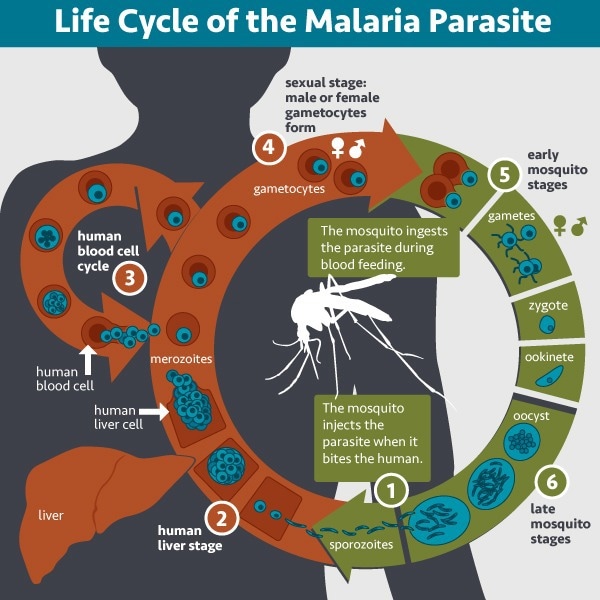Malaria killed over 600,000 people in 2022, a death toll that has not improved since 2015. Five Plasmodium species cause malaria in humans: P. falciparum, P. vivax, P. ovale, P. malariae, and P. knowlesi. Among these, P. falciparum accounts for the most cases and deaths. Malaria can persist despite treatment and pre-existing immunity. Drug resistance of parasites and insecticide resistance of mosquitoes impair malaria control. Additionally, parasites and mosquitoes resistant to existing interventions are spreading across Africa and other regions. A report highlighted that climate-induced factors such as food and economic insecurity could displace non-immune groups to endemic areas, thereby increasing the risk of malaria transmission.

An illustration of the life cycle of the malaria parasite.
The 2023 World Malaria Report highlights that increasing temperature, humidity, and rainfall benefit parasite and vector multiplication, increasing transmission intensity and expanding at-risk areas. R21 and RTS,S are the first licensed vaccines for malaria, targeting the circumsporozoite protein (CSP) of sporozoites. When deployed at scale, these vaccines may prevent child deaths annually. This provides impetus to enhance first-generation products and pursue goals like the protection of pregnant individuals and malaria eradication. Therefore, the present study reviewed the malaria vaccine landscape to inform future development, underscoring its successes and failures.
RTS,S is recommended for children in moderate-to-high-transmission zones to reduce clinical malaria. In phase III testing, RTS,S reduced clinical malaria by approximately 36% over 48 months from the first vaccine dose. R21, approved by Ghana and Nigeria in 2023, reduced clinical malaria over the subsequent 12 months by approximately 75% (seasonal administration) or 68% (standard administration).
Malaria vaccine approaches by parasite life cycle stage
Pre-erythrocyte stage vaccines target the liver stages and clinically silent sporozoite to prevent infection. Intrahepatic parasites are targeted by T cells, while antibodies target sporozoites. Blood-stage vaccines target merozoite invasion proteins. Among 37 blood-stage vaccine trials between 2001 and 2015, 32 focused on three merozoite proteins – apical membrane antigen 1, merozoite surface protein 1 (MSP1), and MSP3, which had minimal or no effectiveness in field or challenge studies. The infected erythrocyte is an alternative blood-stage target; however, the variation in surface-dominant P. falciparum erythrocyte membrane protein 1 (PfEMP1) family has precluded broad vaccines. Nevertheless, one distinct PfEMP1, VAR2CSA, may be an exception. It is expressed on the surface of infected erythrocytes that sequester in the placenta, resulting in adverse pregnancy outcomes. It is the leading vaccine candidate for pregnancy malaria. Further, transmission-blocking vaccines induce antibodies against mosquito antigens or sporogonic- or sexual-stage parasites within mosquitoes.
Limitations, improvements, and optimizations of vaccines
While R21 and RTS,S vaccines are remarkable achievements, their protection wanes over a year, warranting annual boosts. Besides, their efficacy may vary with the intensity of transmission and vaccination timing relative to transmission season. Further, saponin extracts from Quillaja Saponaria are incorporated into vaccine adjuvants; their supply is not unlimited. Moreover, these vaccines are only indicated for young children.
 Quillaja saponaria, the soap bark tree or soapbark, is an evergreen tree in the family Quillajaceae. Image Credit: Akif CUBUK / Shutterstock
Quillaja saponaria, the soap bark tree or soapbark, is an evergreen tree in the family Quillajaceae. Image Credit: Akif CUBUK / Shutterstock
The efficacy of R21 in phase 3 trials is higher than that of RTS,S. While both vaccines incorporate similar P. falciparum CSP (PfCSP) fragments, R21 displays PfCSP on all hepatitis B surface antigen (HBsAg) capsid subunits, unlike RTS,S, which displays on about 20% of these subunits. Thus, 5 μg of R21 yields similar PfCSP content as 25 μg of RTS,S. Efforts to enhance the titer and activity of blood-stage vaccines have relied on several adjuvants, such as AS02, Alhydrogel, and GLA-SE. Further, coronavirus disease 2019 (COVID-19) vaccines use chemically modified nucleotides to reduce innate immunostimulatory responses. This approach has been implemented for P. falciparum-infected erythrocyte surface glutamate-rich protein (PfGARP), P. vivax ookinete surface protein 25 (Pvs25), and PfCSP, with promising results in preclinical studies. In addition, fractional dosing improved RTS,S efficacy against sporozoite challenge. Fractional dosing and other regimens are being investigated for the R21 vaccine. Vaccination timing can be advantageous. For instance, RTS,S administration before the transmission season increased effectiveness. Further, combining seasonal malarial chemoprevention (SMC) with seasonal RTS,S vaccination decreased clinical malaria by 62.8% relative to SMC alone.
Addressing the needs of endemic communities
Fetal, neonatal, maternal, and infant deaths due to pregnancy malaria are substantially high. Treated pregnancy infections are associated with fetal/neonatal death. Therefore, vaccines should be developed to reduce placental infections. Preconception administration of the attenuated P. falciparum whole-sporozoite (PfSPZ) vaccine has been efficacious against pregnancy infections over the next two years, laying the groundwork for investigations in pregnant individuals. P. vivax caused 18% to 72% of malaria cases in non-African endemic areas in 2020. It generates hypnozoites, viz., dormant parasites, in the liver, which relapse over months/years, impeding elimination efforts. Further, drugs clearing hypnozoites cause hemolysis in people deficient in glucose-6-phosphate dehydrogenase, hampering treatment. Vaccines for P. vivax have been sparse but effective.
Concluding remarks
Together, R21 and RTS,S vaccines will decrease childhood mortality following large-scale deployment in Africa. Combining seasonal vaccination with chemoprevention reduced malaria by about 20-fold relative to historical rates in Mali and Burkina Faso, suggesting that additional improvements can be achieved in child health. Further, new vaccine candidates and concepts may enhance vaccination effectiveness and expand indications in the future.